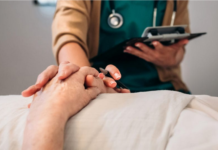Wearing the proper clothes after surgery is key to keeping comfortable and promoting recovery. While a hospital gown can work for a while, you may want to wear clothes that feel more like you. There’s a whole selection of garments specifically designed for patients recovering from surgery. Here are six tips for choosing the perfect post-surgery wear, plus more suggestions for encouraging healing after surgery:
Think about your mobility.
What type of post-surgical clothes that you choose will depend on what type of surgery you had and how limited your mobility is afterwards. For example, if you are having rotator cuff surgery, then you need to plan on getting dressed with one hand only and buy garments that will allow you to do that. If you are having knee surgery, then you will want pants with an elastic waist and wide, stretchy legs so you can easily slide them over the site. If you’re not sure what kind of post-surgery clothing you might need, you can ask your doctor for recommendations.
Determine what features you need.
Different post-surgical garments are designed to fit different needs. Some have snaps or magnetic closures to make them easier to don and doff with limited mobility or only one hand. Some tops and gowns are made with an open back to relieve pressure on the surgery site and make it easier to change the dressings. Consider what type of surgery you are having and what kind of features would be helpful to your recovery. Use that to narrow down your options for post-surgery clothing.
Avoid heavy, binding clothes.
Denim jeans are a no-no after surgery. They are made of heavy fabric that will scratch against your skin and the tight waistband will cut into your stomach, causing discomfort and chafing. Avoid any other kind of clothing with a tight waistband, heavy fabric or constricting design. If you have had surgery in the abdominal or pelvic region, you might want to choose a gown or dress so that you don’t have a waistband pressing on the area at all — even a soft elastic one. You’ll be back in your regular clothes before you know it, so enjoy the opportunity to live in loose, soft clothes after your surgery.
Watch out for seams.
Seams can cause pressure and chafing, resulting in discomfort and potentially irritating the incision site. Make sure that your clothing does not have any seams that will run right over the surgery site or otherwise press or rub against it. Choose clothing that has minimal seams or a seamless design that will minimize your overall discomfort. Even if they’re not near the surgery site, seams can still cause irritation, especially if you sit or lie on top of them for long periods of time (which is common for bed rest after surgery).
Seek out soft fabrics.
A seamless design doesn’t matter if the fabric itself is scratchy and rough. Choose clothing made of fabric that’s as soft on the inside as it is on the outside, so the part that goes next to your skin feels nice. Keep in mind that you can’t necessarily tell how a fabric will feel just from reading the tag because materials such as cotton, polyester and rayon can feel totally different depending on the way they are woven together. If you’re buying online, seek out garments that are specifically designed to be post-surgery clothing to ensure they will be soft.
Don’t forget your shoes.
Footwear is often an afterthought, but shoes are a vital piece of your post-surgery wardrobe. Even if you’re not planning to go out for a while, wearing non-slip shoes inside the house will help keep you stable and prevent falls. Look for slip-on designs or zipper closures so you don’t have to mess with shoelaces. If your surgery has impacted your ability to bend over, a long-handled shoe horn can help you get into and out of shoes without having to lean over too much. Bear in mind that swelling in the days after surgery is normal, and thus your normal shoe size might not fit.

By Pormezz / Shutterstock.com
Hospital clothes for patients aren’t the only way to ease your recovery. Here are some tips to help you heal after surgery:
- Monitor your fever using your thermometer so you can watch for signs of infection.
- Keep pain and inflammation in check with pain medications, either over the counter or prescribed by your doctor.
- Keep extra pillows on hand for support.
- Take a stool softener if you become constipated after the anesthesia.
- Eat high protein snacks and meals to give your body the nutrients that it needs to recover.
- Rest when you are fatigued, but try not to take naps that are so long that they mess with your regular sleep cycles.
- Take walks once your doctor gives you the okay to get your blood moving and help prevent clots.
- Let your loved ones help you with cooking, cleaning and other daily chores so you can focus on resting and recovering.
- Contact your doctor if you experience increased or uncontrolled pain, chills, a fever over 101 degrees Fahrenheit or signs of infection (redness, warmth, drainage, etc.) from the incision site.
Post-surgical clothing can support your healing journey as you recover after surgery. Follow these six steps to identify the perfect surgery recovery clothes for your needs and to stay comfortable after surgery.

















